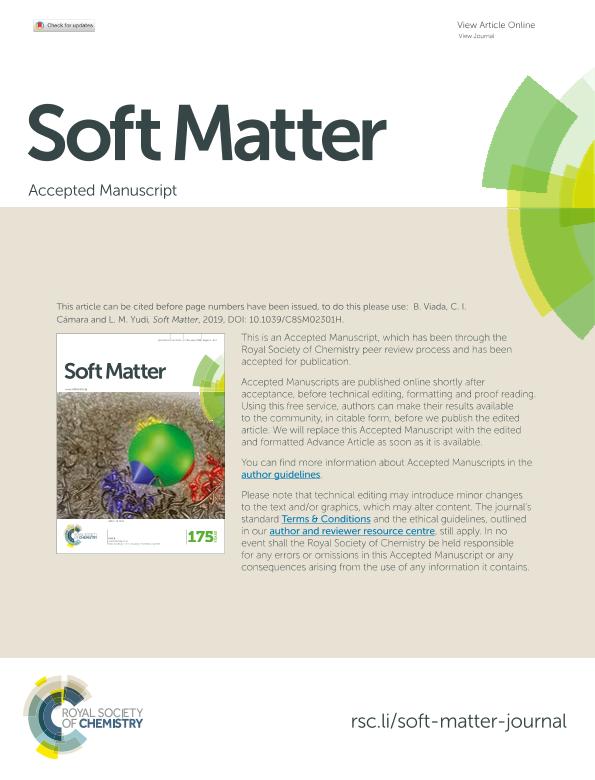Mostrar el registro sencillo del ítem
dc.contributor.author
Viada, Benjamín Nahuel

dc.contributor.author
Cámara, Candelaria Inés

dc.contributor.author
Yudi, Lidia Mabel

dc.date.available
2021-02-08T21:04:14Z
dc.date.issued
2019-01
dc.identifier.citation
Viada, Benjamín Nahuel; Cámara, Candelaria Inés; Yudi, Lidia Mabel; Destabilizing effect of perfluorodecanoic acid on simple membrane models; Royal Society of Chemistry; Soft Matter; 15; 11; 1-2019; 2447-2462
dc.identifier.issn
1744-683X
dc.identifier.uri
http://hdl.handle.net/11336/125146
dc.description.abstract
Perfluoroalkyl acids (PFA) are amphiphilic surfactants widely used in industry with several commercial applications. An important feature of these compounds is their non-biodegradability and their tendency to bio-accumulate in the environment, which has led to these compounds being considered among the most persistent pollutants worldwide. Many studies have provided evidence of their toxic effect on humans and wildlife. For this reason, more and more efforts have been made to better understand the effect of these compounds on living organisms. The aim of the present study is to understand how the electrostatic interactions and film compactness of biological membrane models modulate their interaction with PFA, more specifically with perfluorodecanoic acid (PFD). Langmuir isotherms and Brewster angle microscopy (BAM) are used to evaluate the effect of PFD on lipid membrane models (air/water monolayers and vesicles), analyzing the behavior of PFD : lipid mixtures. The lipids used in this study are distearoyl phosphatidic acid (DSPA), dilauroyl phosphatidic acid (DLPA) and distearoyl phosphatidylethanolamine (DSPE). PFD induces an increase in the mean molecular area per lipid in monolayers, mainly at lower surface pressures. BAM images demonstrate that PFD mixes with DLPA, inducing a decrease in gray level, while it forms a non-miscible mixture with DSPA, segregating PFD domains. Insertion studies of PFD within monolayers and dynamic light scattering experiments demonstrate that PFD can penetrate into monolayers and bilayers above 30 mN m−1, which is the lateral pressure value accepted for a cellular bilayer.
dc.format
application/pdf
dc.language.iso
eng
dc.publisher
Royal Society of Chemistry

dc.rights
info:eu-repo/semantics/openAccess
dc.rights.uri
https://creativecommons.org/licenses/by-nc-sa/2.5/ar/
dc.subject
PERFLUORODECANOIC ACID
dc.subject
BREWSTER ANGLE MICROSCOPY
dc.subject
PHOSPHOLIPIDS
dc.subject
EXCLUSION PRESSURE
dc.subject
MICELLES
dc.subject
EXCLUSION PRESSURE
dc.subject.classification
Biofísica

dc.subject.classification
Ciencias Biológicas

dc.subject.classification
CIENCIAS NATURALES Y EXACTAS

dc.title
Destabilizing effect of perfluorodecanoic acid on simple membrane models
dc.type
info:eu-repo/semantics/article
dc.type
info:ar-repo/semantics/artículo
dc.type
info:eu-repo/semantics/publishedVersion
dc.date.updated
2020-11-17T18:36:13Z
dc.identifier.eissn
1744-6848
dc.journal.volume
15
dc.journal.number
11
dc.journal.pagination
2447-2462
dc.journal.pais
Reino Unido

dc.journal.ciudad
Cambridge
dc.description.fil
Fil: Viada, Benjamín Nahuel. Universidad Nacional de Córdoba; Argentina. Consejo Nacional de Investigaciones Científicas y Técnicas. Centro Científico Tecnológico Conicet - Córdoba. Instituto de Investigaciones en Físico-química de Córdoba. Universidad Nacional de Córdoba. Facultad de Ciencias Químicas. Instituto de Investigaciones en Físico-química de Córdoba; Argentina
dc.description.fil
Fil: Cámara, Candelaria Inés. Universidad Nacional de Córdoba; Argentina. Consejo Nacional de Investigaciones Científicas y Técnicas. Centro Científico Tecnológico Conicet - Córdoba. Instituto de Investigaciones en Físico-química de Córdoba. Universidad Nacional de Córdoba. Facultad de Ciencias Químicas. Instituto de Investigaciones en Físico-química de Córdoba; Argentina
dc.description.fil
Fil: Yudi, Lidia Mabel. Universidad Nacional de Córdoba; Argentina. Consejo Nacional de Investigaciones Científicas y Técnicas. Centro Científico Tecnológico Conicet - Córdoba. Instituto de Investigaciones en Físico-química de Córdoba. Universidad Nacional de Córdoba. Facultad de Ciencias Químicas. Instituto de Investigaciones en Físico-química de Córdoba; Argentina
dc.journal.title
Soft Matter

dc.relation.alternativeid
info:eu-repo/semantics/altIdentifier/doi/https://doi.org/10.1039/C8SM02301H
Archivos asociados
